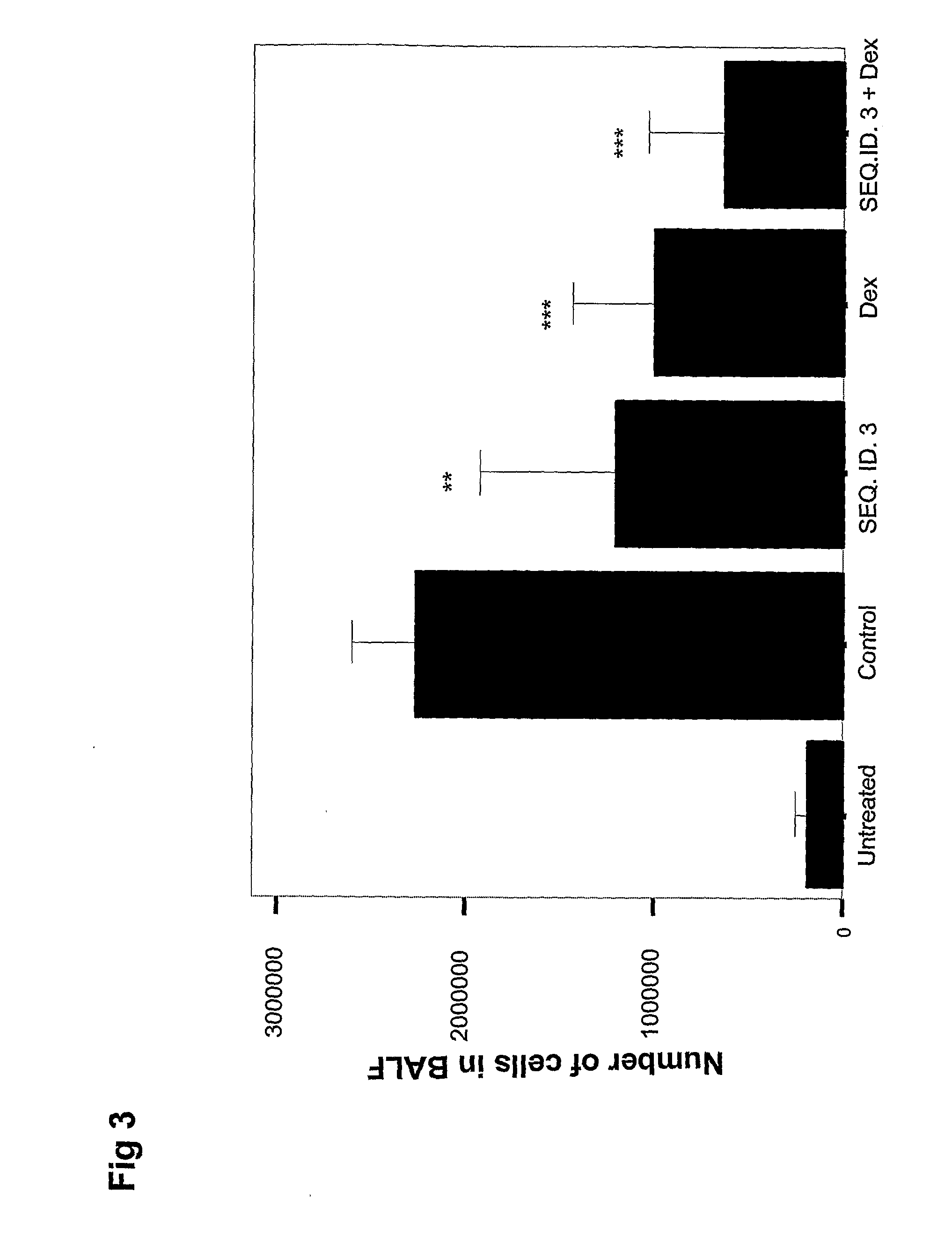Composition and Method for the Prevention, Treatment and/or Alleviation of an Inflammatory Disease
a technology for inflammatory diseases and compounds, applied in the direction of gene therapy, sugar derivatives, respiratory disorders, etc., can solve the problems of inability to respond, harmful reactions produced during inflammation, and approximately 5% of asthma patients not being controlled
- Summary
- Abstract
- Description
- Claims
- Application Information
AI Technical Summary
Benefits of technology
Problems solved by technology
Method used
Image
Examples
example 2
First Animal Study
[0139]The general aim of this study was to examine the pharmacological effects of an experimental oligonucleotide SEQ. ID. NO. 3, as a potential immunomodulating compound. The aim of the study was to examine the pharmaceutical effects of SEQ. ID. NO. 3 using airway inflammation as disease endpoint, and to compare the efficacy with that of corticosteroids.
[0140]Materials and Methods
[0141]Animals
[0142]C57BL / 6 mice were purchased from Bomholtgaard, Ry, Denmark. Animals were fed with standard chow and water ad libitum and allowed to acclimatize for at least 7 days in an accredited animal facility before use. In all experiments female mice of ages between 9-11 weeks were used. All experiments were approved by the local ethical committee for animal experiments in Ume{dot over (a)}, Sweden.
[0143]Induction of Acute Lung Inflammation
[0144]Bacterial endotoxin, LPS (Escherichia coli 0128:B12, Sigma, St. Louis, Mo.) was administered to anaesthetised mice (enflurane) by trachea...
example 3
Second LPS Induced Asthma Study
[0158]As with example 2, aim of the study was to examine the pharmaceutical effects of SEQ. ID. NO. 3 using airway inflammation as disease endpoint, and to compare the efficacy with that of corticosteroids. This study included larger numbers of animals per group to increases statistical significance. The induction of LPS induced asthma and the protocol of analyses was conducted as described in example 2.
[0159]Briefly, mice were treated with an SEQ.ID.NO 3 (150 μg / animal) administered by tracheal instillation 18 h prior to challenge with 5 μg LPS. One group of mice represented healthy untreated individuals. Control mice were given solvent only (H2O) and LPS. One group received dexamethasone (5 mg / kg) one hour before LPS instillation and one group were given a combination treatment. Analysis of BALF was performed 20 hours after the last treatment. Total number of cells in BALF and number of neutrophils is shown. Data is expressed as mean±SD. ***=p<0.001 ...
example 4
Third LPS Induced Asthma Study
[0165]As with examples 1 and 2, aim of the study was to examine the pharmaceutical effects of SEQ. ID. NO. 3 using airway inflammation as disease endpoint, and to compare the efficacy with that of corticosteroids. In addition, a number of control oligonucleotides were included being SEQ.ID.NO 4, and SEQ.ID.NO 7. The induction of LPS induced asthma and the protocol of analyses was conducted as described in Example 2.
[0166]Briefly, LPS-induced airway inflammation in mice was treated with SEQ.ID.NOs 3, 4 and 7 (150 μg / animal) administered by tracheal instillation 18 h prior to challenge with 5 μg LPS. The untreated group represents healthy individuals and mice in the control group were given solvent only (H2O+LPS). The control treatment of dexamethasone (5 mg / kg, i.p.) was given one hour before LPS instillation. Analysis of BAL fluid was performed 20 hours after LPS instillation. The total number of leukocytes and neutrophils in BAL fluid is shown. Data ex...
PUM
| Property | Measurement | Unit |
|---|---|---|
| length | aaaaa | aaaaa |
| molecular weight | aaaaa | aaaaa |
| weight | aaaaa | aaaaa |
Abstract
Description
Claims
Application Information
 Login to View More
Login to View More - Generate Ideas
- Intellectual Property
- Life Sciences
- Materials
- Tech Scout
- Unparalleled Data Quality
- Higher Quality Content
- 60% Fewer Hallucinations
Browse by: Latest US Patents, China's latest patents, Technical Efficacy Thesaurus, Application Domain, Technology Topic, Popular Technical Reports.
© 2025 PatSnap. All rights reserved.Legal|Privacy policy|Modern Slavery Act Transparency Statement|Sitemap|About US| Contact US: help@patsnap.com



